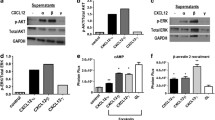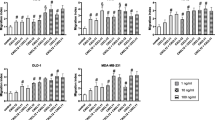Abstract
There is growing evidence that several chemokine receptors including CXCR3 contribute to metastasis of breast and other cancers, however, in order to target CXCR3 effectively, it is critical to understand the relative contribution of each CXCR3 isoform. Furthermore, the possible contribution of either major CXCR3 isoform (CXCR3-A, CXCR3-B) to cancer stem cell behavior has not been reported. We employed primary invasive ductal carcinomas, a panel of breast cell lines, and a xenograft model of metastatic breast cancer to examine the role of CXCR3 isoforms in the behavior of breast cancer stem-like cells and the contribution of each isoform to metastasis. In primary human breast cancer specimens as well as established breast cancer cell lines, CXCR3-A is more highly expressed than CXCR3-B. Conversely, immortalized normal MCF10A cells express more CXCR3-B relative to CXCR3-A. Overexpression of CXCR3-B in MDA-MB-231 basal-like cells inhibits CXCR3 ligand-stimulated proliferation, which is accompanied by reduced ligand-mediated activation of ERK1/2 and p38 kinases. Likewise, metastatic capacity is reduced in vivo by higher levels of CXCR3-B, and migratory and invasive properties are inhibited in vitro; conversely, silencing of CXCR3-B enhances lung colonization. In contrast to the anti-metastatic and anti-proliferative roles of CXCR3-B in the non-stem cell population, this isoform supports a cancer stem-like cell phenotype. CXCR3-B is markedly elevated in mammosphere-forming parental cells and overexpressing CXCR3-B further enhances mammosphere-forming potential as well as growth in soft agar; stem-like behavior is inhibited in MDA-MB-231shCXCR3-B cells. Targeting of both CXCR3 isoforms may be important to block the stem cell-promoting actions of CXCR3-B, while inhibiting the pro-proliferative and metastasis-promoting functions of CXCR3-A.






Similar content being viewed by others
References
Fulton A (ed) (2009) Chemokine receptors in cancer. Springer Publisher, Dordrecht
Billottet C, Quemener C, Bikfalvi A (2013) CXCR3, a double-edged sword in tumor progression and angiogenesis. Biochim Biophys Acta 1836:287–295
Li Y, Fulton AM (2012) CXCR3/CXCL3 axis: friend or foe? In: Ben-Baruch A (ed) The inflammatory milieu of tumors: cytokines and chemokines that affect tumor growth and metastasis. Bentham Science Publishers, United Arab Emirates, pp 88–98
Goldberg-Bittman L, Neumark E, Sagi-Assif O, Azenshtein E, Meshel T, Witz IP, Ben-Baruch A (2004) The expression of the chemokine receptor CXCR3 and its ligand, CXCL10, in human breast adenocarcinoma cell lines. Immunol Lett 92(1–2):171–178
Ma X, Norsworthy K, Kundu N, Rodgers WH, Gimotty PA, Goloubeva O, Lipsky M, Li Y, Holt D, Fulton A (2009) CXCR3 expression is associated with poor survival in breast cancer and promotes metastasis in a murine model. Mol Cancer Ther 8(3):490–498
Hilborn E, Sivik T, Fornander T, Stal O, Nordenskjold B, Jansson A (2014) CXC ligand 10 and CXC receptor 3 status can predict tamoxifen treatment response in breast cancer patients. Breast Cancer Res Treat 145:73–82
Walser T, Rifat S, Ma X, Kundu N, Ward C, Goloubeva O, Johnson M, Medina J, Collins T, Fulton A (2006) Antagonism of CXCR3 inhibits lung metastasis in a murine model of metastatic breast cancer. Cancer Res 66:7701–7707
Datta D, Flaxenburg JA, Laxmanan S, Geehan C, Grimm M, Waaga-Gasser AM, Briscoe DM, Pal S (2006) Ras-induced modulation of CXCL10 and its receptor splice variant CXCR3-B in MDA-MB-435 and MCF-7 cells: relevance for the development of human breast cancer. Cancer Res 66(19):9509–9518
Mulligan AM, Raitman I, Feeley L, Pinnaduwage D, Nguyen LT, O’Malley FP, Ohashi PS, Andrulis I (2013) Tumoral lymphocytic infiltration and expression of the chemokine CXCL10 in breast cancers from the Ontario Familial Breast Cancer Registry. Clin Cancer Res 19:336–346
Lasagni L, Francalanci M, Annunziato F, Lazzeri E, Giannini S, Cosmi L et al (2003) An alternatively spliced variant of CXCR3 mediates the inhibition of endothelial cell growth induced by IP-10, Mig, and I-TAC, and acts as functional receptor for platelet factor 4. J Exp Med 197(11):1537–1549
Robledo MM, Bartolomé RA, Longo N, Rodríguez-Frade JM, Mellado M, Longo I, van Muijen GNP, Sánchez-Mateos P, Teixidó J (2001) Expression of functional chemokine receptors CXCR3 and CXCR4 on human melanoma cells. J Biol Chem 276(48):45098–45105
Kawada K, Hosogi H, Sonoshita M, Sakashita H, Manabe T, Shimahara Y, Sakai Y, Takabayashi A, Oshima M, Taketo MM (2007) Chemokine receptor CXCR3 promotes colon cancer metastasis to lymph nodes. Oncogene 26(32):4679–4688
Wu Z, Dhir R, Wells A (2012) Altered CXCR3 isoform expression regulates prostate cancer cell migration and invasion. Mol Cancer 11:3
Utsumi T, Suyama T, Imamura Y, Fuse M, Sakamoto S, Nihei N, Ueda T, Suzuki H, Seki N, Ichikawa T (2014) The association of CXCR3 and renal cell carcinoma metastasis. J Urol 192:567
Petrai I, Rombouts K, Lasagni L, Annunziato F, Cosmi L, Romanelli RG et al (2008) Activation of p38MAPK mediates the angiostatic effect of the chemokine receptor CXCR3-B. Int J Biochem Cell Biol 40(9):1764–1774
Balan M, Pal S (2014) A novel CXCR3-B chemokine receptor induced growth inhibitory signal in cancer cells is mediated through the regulation of Bach-1 protein and Nrf2 protein nuclear translocation. J Biol Chem 289:3126–3137
Shin SY, Nam J-S, Lim Y, Lee YH (2010) TNFα-exposed bone marrow derived mesenchymal stem cells promote locomotion of MDA-MB-231 breast cancer cells through transcriptional activation of CXCR3 ligand chemokines. J Biol Chem 285:30731–30740
Kundu S, Ma X, Kochel T, Goloubeva O, Staats P, Thompson K, Martin S, Reader J, Take Y, Collin P, Fulton A (2014) Prostaglandin E receptor EP4 is a therapeutic target in breast cancer cells with stem-like properties. Breast Cancer Res Treat 143:19–31
Pfeiffer M, Hartmann TN, Leick M, Catusse J, Schmitt-Graeff A, Burger M (2009) Alternative implication of CXCR4 in JAK2/STAT3 activation in small cell lung cancer. Br J Cancer 100:1949–1956
Dubrovska A, Hartung A, Bouchez LC, Walker JR, Reddy VA, Cho CY, Schultz PG (2012) CXCR4 activation maintains a stem cell population in tamoxifen-resistant breast cancer cells through AhR signalling. Br J Cancer 107(1):43–52
Yi T, Zhai B, Yu Y, Kiyotsugu Y, Raschle T, Etzkorn M, Seo H-C et al (2014) Quantitative phosphoproteomic analysis reveals system-wide signaling pathways downstream of SDF-1/CXCR4 in breast cancer stem cells. Proc Natl Acad Sci 111:E2182–E2190
Ginestier C, Liu S, Diebel ME, Korkaya H, Luo M, Brown M, Wicinski J et al (2010) CXCR1 blockade selectively targets human breast cancer stem cells in vitro and in xenografts. J Clin Invest 120:485–497
Hanahan D, Weinberg RA (2011) Hallmarks of cancer: the next generation. Cell 144:646–674
Zohar Y, Wildbaum G, Novak R, Salzman AL, Thelen M, Alon R, Barsheshet Y et al (2014) CXCL11-dependent induction of FOXP3-negative regulatory T cells suppresses autoimmune encephalomyelitis. J Clin Invest 124:2009–2022
Patsialou A, Wang Y, Pignatelli J, Chen X, Entenberg D, Oktay M, Condeelis JS (2014) Autocrine CSF1R signaling mediates switching between invasion and proliferation downstream of TGFβ in claudin-low breast tumor cells. Oncogene. doi:10.1038/onc.2014.226
Acknowledgement
We thank Dr. Steven Kelsen, Temple University for the provision of a CXCR3-B retroviral expression plasmid. This study was supported by the U.S. Department of Defense Breast Cancer Research Program.
Conflict of interest
All authors declare no conflict of interest.
Author information
Authors and Affiliations
Corresponding author
Rights and permissions
About this article
Cite this article
Li, Y., Reader, J.C., Ma, X. et al. Divergent roles of CXCR3 isoforms in promoting cancer stem-like cell survival and metastasis. Breast Cancer Res Treat 149, 403–415 (2015). https://doi.org/10.1007/s10549-014-3229-7
Received:
Accepted:
Published:
Issue Date:
DOI: https://doi.org/10.1007/s10549-014-3229-7




